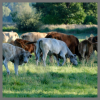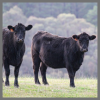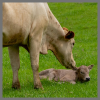-

Sep
04
Interpretive Summary: Standardized ileal digestible lysine (protein) intake by primiparous sows should be increased in late gestation to maximize whole-body nitrogen retention, piglet birth weight, and subsequent milk yield

In late gestation, the amino acid requirements of primiparous sows increase substantially due to growth of the fetal pool and mammary gland development. Dietary Lys (protein) supply in late gestation can influence mammary development by the end of gestation, with an unknown impact on subsequent milk production.
Read more
-

Sep
04
Interpretive Summary: Increasing dietary soybean-derived trypsin inhibitor protein compromises nursery pig performance, nitrogen digestibility, and retention

Trypsin inhibitor proteins are intrinsic to soybeans and soy products, presenting an omnipresent antinutritional factor challenging soy-based product use in swine diets. Increasing dietary trypsin inhibitor (TIU/mg) protein linearly compromises growth performance, feed efficiency, and nitrogen retention as soybean TIU increased in the diet of nursery pigs. These performance outcomes were caused by reductions in nitrogen digestibility and retention.
Read more
-

Sep
04
Interpretive Summary: A “berry” small inclusion: 40 types of commercial dog and cat kibble with added blueberries provide low levels of quercetin, free phenolics, and alkali-labile phenolics

Many pet food brands claim blueberries are a source of antioxidants, promoting their health benefits. Blueberries are rich in polyphenols, plant compounds known for their antioxidant and anti-inflammatory properties, which can support human and animal health.
Read more
-

Sep
04
Interpretive Summary: Impact of an abrupt change from dry to canned diet on digestive function and gut microbiota in dogs

Changes of diet in dogs are recommended to be gradual, as sudden introductions can cause vomiting and diarrhea. However, from a research point of view, a swift dietary change could be a model of gastrointestinal disturbance to test the impact of feed additives aimed at fostering gut resilience.
Read more
-

Aug
28
Washington Roundup – August 2025

Congress left for August recess after passing the “Big, Beautiful Bill”, which addressed many of the major Farm Bill funding programs. However, due to the Byrd Rule in the Senate, many programs must still be reauthorized, or face expiration at the end of September. Chairman Thompson (R-PA) has dubbed the remaining work as “Farm Bill 2.0”. He estimates that Farm Bill 2.0 should be less controversial and able to garner more bipartisan support than the Big, Beautiful Bill.
Read more
-

Aug
28
Interpretive Summary: Space-Age Tools For Old-School Grazing Management

One of the oldest human-managed uses of the physical world is animal husbandry. This has always been a fascinating, complex combination of scientific understanding of natural resources and animals and the contextual application of that knowledge, which builds on itself in the doing.
Read more
-

Aug
28
Interpretive Summary: Emerging Technology for Quantifying Diet Composition of Grazing Animals

Determining what plants grazing animals are eating has been a persistent challenge for animal and rangeland scientists (Holechek et al. 1982). This challenge not only applies to important livestock species such as cattle, sheep, and horses but also wildlife – all of which often or always inhabit large extensive rangelands with complex plant communities.
Read more
-

Aug
28
Interpretive Summary: Cow Size: Implications for Grazing Rangelands and the Beef Industry

Beef cows have been getting larger over the past 4 to 5 decades which can create problems for many different segments of the beef industry (Scasta, et al. 2019). According to the United States Beef Improvement Federation and National Cattle Slaughter Summary, in 1975 the average U.S. beef cow weighed ~1,050 pounds and by 2009 weighed ~1,350 pounds, and today it is thought they weigh ~1,400 pounds but potentially stabilizing (Wiseman et al. 2018).
Read more
-

Aug
28
Interpretive Summary: Assessing the Efficacy and the Conservation Benefit of Virtual Fence on Rugged and Remote Landscapes

For producers and those outside agriculture, virtual fence provokes hope, novelty, and interest. But how does it work on rugged, mountainous terrain in remote areas?
Our recent project, Managing Rangelands with Virtual Fencing for Grazing Lands Conservation in Western Colorado, aimed to assess this question.
Read more
-

Aug
21
Interpretive Summary: Impacts of heat stress on growth performance and its mitigation in small ruminants

Small ruminants have been amongst the first farm animals to be domesticated by humans. Primarily, these animals are raised for meat, milk and skin ensuring global food security in addition to providing draught power and financial services. Small ruminants are highly valued for their versatility and excellent adaptability to varied geographical and climatic conditions as evident from their wide distribution pattern in Asian and African continents with rough climatic conditions.
Read more
-

Aug
21
Interpretive Summary: Impacts of stress on growth and reproductive development of beef heifers

The success of cow-calf operations is fundamentally tied to the performance and management of beef females, as they are expected to maintain estrous cyclicity and produce one calf per cow annually. A combination of factors, including nutrition and management practices, affect reproductive success in cattle, and therefore overall fertility and herd performance.
Read more
-

Aug
21
Interpretive Summary: Charting a course on the effects of ocean and sea transportation stress on cattle and sheep body weight changes, behavior, and nutrient mobilization

Transportation is a necessary part of ruminant livestock production, with most animals being transported at least once in their lifetime, if not more frequently. Livestock are transported for a variety of reasons, including growing and finishing, harvesting, acquiring new genetics, and show purposes. However, transportation can be a potential stressor for livestock that can impact skeletal muscle, growth, and meat quality (Dalmau et al., 2013; Deters and Hansen, 2022).
Read more
-

Aug
21
Interpretive Summary: Factors contributing to differences in stress resilience and growth performance between Bos taurus and Bos indicus cattle

As the world population is projected to increase to 9.15 billion by 2050, demand for agricultural products is expected to increase 60% (Alexandratos and Bruinsma, 2012). Current cattle production practices will not meet increasing demand. The U.S. primarily produces Bos taurus cattle and ranks first in beef exports worldwide, accounting for 20% of the world supply (Colditz and Hine, 2016; Scheffler, 2022; USDA, 2024).
Read more
-

Aug
21
Interpretive Summary: Plant tannin for grazing ruminant growth

Tannins have long been used to preserve and tan leather. There are reports of tannin use dating back to the late Neolithic period (Falcão and Araujo, 2018), when aqueous extracts with plant parts were used to prevent the degradation of slaughtered animal skins, transforming them into leather.
Read more
-

Aug
20
The Giving Herd - ASAS Foundation Newsletter - August 2025

The August Edition of The Giving Herd, an ASAS Foundation Newsletter
Read more
-

Aug
19
A Life Bridging Animal and Human Science - Teresa A. Davis' Story

A Life Bridging Animal and Human Science - Teresa A. Davis' Story
Read more
-

Aug
14
Interpretive Summary: Effect of precision feeding standardized ileal digestible lysine and other amino acids to lactating sows compared to conventional feeding strategies in a commercial farm

Sows are usually fed a single diet during lactation regardless of factors that affect nutrient requirements such as parity, milk production, and litter growth rate. Precision feeding through diet blending can be used to target an individual sow’s nutrient requirement and decrease diet costs compared to traditional feeding strategies.
Read more
-

Aug
14
Interpretive Summary: Effects of 25-hydroxycholecalciferol supplementation during gestation on sow performance, offspring development, and intestinal microbiota in sows and piglets

Vitamin D (VD) plays an important role in bone mineralization and animal reproductive performance. As a metabolite of VD in the liver, 25-hydroxycholecalciferol (25OHD3) is gradually becoming a substitute for VD3. However, reported effects of administering 25OHD3 to sow diet instead of VD3 are inconsistent.
Read more
-

Aug
14
Interpretive Summary: In vitro fermentation characteristics of acacia fiber using feline fecal inoculum

Acacia fiber is a soluble dietary fiber derived from the gum exudate of acacia trees. This fiber is commonly used in the pet food industry as a gelling and emulsifying agent, though its effects on feline gastrointestinal health are not well understood. The current experiment used a batch in vitro system and feline fecal inoculum to mimic the colonic bacterial fermentation process and assess the fermentation characteristics of an acacia fiber blend, inulin, pectin (positive control), and cellulose (negative control).
Read more
-

Aug
14
Interpretive Summary: Maternal supplementation of a Bacillus-based direct-fed microbials altered the cow prepartum plasma metabolome and the calf plasma metabolome before and after vaccination

Direct-fed microbials (DFM), such as Bacillus spp., can enhance digestion and support the immune function of cattle. Nutritional management of beef cows during gestation and early lactation may enhance future offspring performance by multiple mechanisms, including modifying maternal and offspring blood metabolites.
Read more
 SepInterpretive Summary: Standardized ileal digestible lysine (protein) intake by primiparous sows should be increased in late gestation to maximize whole-body nitrogen retention, piglet birth weight, and subsequent milk yield
SepInterpretive Summary: Standardized ileal digestible lysine (protein) intake by primiparous sows should be increased in late gestation to maximize whole-body nitrogen retention, piglet birth weight, and subsequent milk yield In late gestation, the amino acid requirements of primiparous sows increase substantially due to growth of the fetal pool and mammary gland development. Dietary Lys (protein) supply in late gestation can influence mammary development by the end of gestation, with an unknown impact on subsequent milk production.
In late gestation, the amino acid requirements of primiparous sows increase substantially due to growth of the fetal pool and mammary gland development. Dietary Lys (protein) supply in late gestation can influence mammary development by the end of gestation, with an unknown impact on subsequent milk production. SepInterpretive Summary: Increasing dietary soybean-derived trypsin inhibitor protein compromises nursery pig performance, nitrogen digestibility, and retention
SepInterpretive Summary: Increasing dietary soybean-derived trypsin inhibitor protein compromises nursery pig performance, nitrogen digestibility, and retention Trypsin inhibitor proteins are intrinsic to soybeans and soy products, presenting an omnipresent antinutritional factor challenging soy-based product use in swine diets. Increasing dietary trypsin inhibitor (TIU/mg) protein linearly compromises growth performance, feed efficiency, and nitrogen retention as soybean TIU increased in the diet of nursery pigs. These performance outcomes were caused by reductions in nitrogen digestibility and retention.
Trypsin inhibitor proteins are intrinsic to soybeans and soy products, presenting an omnipresent antinutritional factor challenging soy-based product use in swine diets. Increasing dietary trypsin inhibitor (TIU/mg) protein linearly compromises growth performance, feed efficiency, and nitrogen retention as soybean TIU increased in the diet of nursery pigs. These performance outcomes were caused by reductions in nitrogen digestibility and retention. SepInterpretive Summary: A “berry” small inclusion: 40 types of commercial dog and cat kibble with added blueberries provide low levels of quercetin, free phenolics, and alkali-labile phenolics
SepInterpretive Summary: A “berry” small inclusion: 40 types of commercial dog and cat kibble with added blueberries provide low levels of quercetin, free phenolics, and alkali-labile phenolics Many pet food brands claim blueberries are a source of antioxidants, promoting their health benefits. Blueberries are rich in polyphenols, plant compounds known for their antioxidant and anti-inflammatory properties, which can support human and animal health.
Many pet food brands claim blueberries are a source of antioxidants, promoting their health benefits. Blueberries are rich in polyphenols, plant compounds known for their antioxidant and anti-inflammatory properties, which can support human and animal health. SepInterpretive Summary: Impact of an abrupt change from dry to canned diet on digestive function and gut microbiota in dogs
SepInterpretive Summary: Impact of an abrupt change from dry to canned diet on digestive function and gut microbiota in dogs Changes of diet in dogs are recommended to be gradual, as sudden introductions can cause vomiting and diarrhea. However, from a research point of view, a swift dietary change could be a model of gastrointestinal disturbance to test the impact of feed additives aimed at fostering gut resilience.
Changes of diet in dogs are recommended to be gradual, as sudden introductions can cause vomiting and diarrhea. However, from a research point of view, a swift dietary change could be a model of gastrointestinal disturbance to test the impact of feed additives aimed at fostering gut resilience. AugWashington Roundup – August 2025
AugWashington Roundup – August 2025 Congress left for August recess after passing the “Big, Beautiful Bill”, which addressed many of the major Farm Bill funding programs. However, due to the Byrd Rule in the Senate, many programs must still be reauthorized, or face expiration at the end of September. Chairman Thompson (R-PA) has dubbed the remaining work as “Farm Bill 2.0”. He estimates that Farm Bill 2.0 should be less controversial and able to garner more bipartisan support than the Big, Beautiful Bill.
Congress left for August recess after passing the “Big, Beautiful Bill”, which addressed many of the major Farm Bill funding programs. However, due to the Byrd Rule in the Senate, many programs must still be reauthorized, or face expiration at the end of September. Chairman Thompson (R-PA) has dubbed the remaining work as “Farm Bill 2.0”. He estimates that Farm Bill 2.0 should be less controversial and able to garner more bipartisan support than the Big, Beautiful Bill. AugInterpretive Summary: Space-Age Tools For Old-School Grazing Management
AugInterpretive Summary: Space-Age Tools For Old-School Grazing Management One of the oldest human-managed uses of the physical world is animal husbandry. This has always been a fascinating, complex combination of scientific understanding of natural resources and animals and the contextual application of that knowledge, which builds on itself in the doing.
One of the oldest human-managed uses of the physical world is animal husbandry. This has always been a fascinating, complex combination of scientific understanding of natural resources and animals and the contextual application of that knowledge, which builds on itself in the doing. AugInterpretive Summary: Emerging Technology for Quantifying Diet Composition of Grazing Animals
AugInterpretive Summary: Emerging Technology for Quantifying Diet Composition of Grazing Animals Determining what plants grazing animals are eating has been a persistent challenge for animal and rangeland scientists (Holechek et al. 1982). This challenge not only applies to important livestock species such as cattle, sheep, and horses but also wildlife – all of which often or always inhabit large extensive rangelands with complex plant communities.
Determining what plants grazing animals are eating has been a persistent challenge for animal and rangeland scientists (Holechek et al. 1982). This challenge not only applies to important livestock species such as cattle, sheep, and horses but also wildlife – all of which often or always inhabit large extensive rangelands with complex plant communities. AugInterpretive Summary: Cow Size: Implications for Grazing Rangelands and the Beef Industry
AugInterpretive Summary: Cow Size: Implications for Grazing Rangelands and the Beef Industry Beef cows have been getting larger over the past 4 to 5 decades which can create problems for many different segments of the beef industry (Scasta, et al. 2019). According to the United States Beef Improvement Federation and National Cattle Slaughter Summary, in 1975 the average U.S. beef cow weighed ~1,050 pounds and by 2009 weighed ~1,350 pounds, and today it is thought they weigh ~1,400 pounds but potentially stabilizing (Wiseman et al. 2018).
Beef cows have been getting larger over the past 4 to 5 decades which can create problems for many different segments of the beef industry (Scasta, et al. 2019). According to the United States Beef Improvement Federation and National Cattle Slaughter Summary, in 1975 the average U.S. beef cow weighed ~1,050 pounds and by 2009 weighed ~1,350 pounds, and today it is thought they weigh ~1,400 pounds but potentially stabilizing (Wiseman et al. 2018). AugInterpretive Summary: Assessing the Efficacy and the Conservation Benefit of Virtual Fence on Rugged and Remote Landscapes
AugInterpretive Summary: Assessing the Efficacy and the Conservation Benefit of Virtual Fence on Rugged and Remote Landscapes For producers and those outside agriculture, virtual fence provokes hope, novelty, and interest. But how does it work on rugged, mountainous terrain in remote areas?
For producers and those outside agriculture, virtual fence provokes hope, novelty, and interest. But how does it work on rugged, mountainous terrain in remote areas? AugInterpretive Summary: Impacts of heat stress on growth performance and its mitigation in small ruminants
AugInterpretive Summary: Impacts of heat stress on growth performance and its mitigation in small ruminants Small ruminants have been amongst the first farm animals to be domesticated by humans. Primarily, these animals are raised for meat, milk and skin ensuring global food security in addition to providing draught power and financial services. Small ruminants are highly valued for their versatility and excellent adaptability to varied geographical and climatic conditions as evident from their wide distribution pattern in Asian and African continents with rough climatic conditions.
Small ruminants have been amongst the first farm animals to be domesticated by humans. Primarily, these animals are raised for meat, milk and skin ensuring global food security in addition to providing draught power and financial services. Small ruminants are highly valued for their versatility and excellent adaptability to varied geographical and climatic conditions as evident from their wide distribution pattern in Asian and African continents with rough climatic conditions. AugInterpretive Summary: Impacts of stress on growth and reproductive development of beef heifers
AugInterpretive Summary: Impacts of stress on growth and reproductive development of beef heifers The success of cow-calf operations is fundamentally tied to the performance and management of beef females, as they are expected to maintain estrous cyclicity and produce one calf per cow annually. A combination of factors, including nutrition and management practices, affect reproductive success in cattle, and therefore overall fertility and herd performance.
The success of cow-calf operations is fundamentally tied to the performance and management of beef females, as they are expected to maintain estrous cyclicity and produce one calf per cow annually. A combination of factors, including nutrition and management practices, affect reproductive success in cattle, and therefore overall fertility and herd performance. AugInterpretive Summary: Charting a course on the effects of ocean and sea transportation stress on cattle and sheep body weight changes, behavior, and nutrient mobilization
AugInterpretive Summary: Charting a course on the effects of ocean and sea transportation stress on cattle and sheep body weight changes, behavior, and nutrient mobilization Transportation is a necessary part of ruminant livestock production, with most animals being transported at least once in their lifetime, if not more frequently. Livestock are transported for a variety of reasons, including growing and finishing, harvesting, acquiring new genetics, and show purposes. However, transportation can be a potential stressor for livestock that can impact skeletal muscle, growth, and meat quality (Dalmau et al., 2013; Deters and Hansen, 2022).
Transportation is a necessary part of ruminant livestock production, with most animals being transported at least once in their lifetime, if not more frequently. Livestock are transported for a variety of reasons, including growing and finishing, harvesting, acquiring new genetics, and show purposes. However, transportation can be a potential stressor for livestock that can impact skeletal muscle, growth, and meat quality (Dalmau et al., 2013; Deters and Hansen, 2022). AugInterpretive Summary: Factors contributing to differences in stress resilience and growth performance between Bos taurus and Bos indicus cattle
AugInterpretive Summary: Factors contributing to differences in stress resilience and growth performance between Bos taurus and Bos indicus cattle As the world population is projected to increase to 9.15 billion by 2050, demand for agricultural products is expected to increase 60% (Alexandratos and Bruinsma, 2012). Current cattle production practices will not meet increasing demand. The U.S. primarily produces Bos taurus cattle and ranks first in beef exports worldwide, accounting for 20% of the world supply (Colditz and Hine, 2016; Scheffler, 2022; USDA, 2024).
As the world population is projected to increase to 9.15 billion by 2050, demand for agricultural products is expected to increase 60% (Alexandratos and Bruinsma, 2012). Current cattle production practices will not meet increasing demand. The U.S. primarily produces Bos taurus cattle and ranks first in beef exports worldwide, accounting for 20% of the world supply (Colditz and Hine, 2016; Scheffler, 2022; USDA, 2024). AugInterpretive Summary: Plant tannin for grazing ruminant growth
AugInterpretive Summary: Plant tannin for grazing ruminant growth Tannins have long been used to preserve and tan leather. There are reports of tannin use dating back to the late Neolithic period (Falcão and Araujo, 2018), when aqueous extracts with plant parts were used to prevent the degradation of slaughtered animal skins, transforming them into leather.
Tannins have long been used to preserve and tan leather. There are reports of tannin use dating back to the late Neolithic period (Falcão and Araujo, 2018), when aqueous extracts with plant parts were used to prevent the degradation of slaughtered animal skins, transforming them into leather. AugThe Giving Herd - ASAS Foundation Newsletter - August 2025
AugThe Giving Herd - ASAS Foundation Newsletter - August 2025 The August Edition of The Giving Herd, an ASAS Foundation Newsletter
The August Edition of The Giving Herd, an ASAS Foundation Newsletter AugA Life Bridging Animal and Human Science - Teresa A. Davis' Story
AugA Life Bridging Animal and Human Science - Teresa A. Davis' Story A Life Bridging Animal and Human Science - Teresa A. Davis' Story
A Life Bridging Animal and Human Science - Teresa A. Davis' Story AugInterpretive Summary: Effect of precision feeding standardized ileal digestible lysine and other amino acids to lactating sows compared to conventional feeding strategies in a commercial farm
AugInterpretive Summary: Effect of precision feeding standardized ileal digestible lysine and other amino acids to lactating sows compared to conventional feeding strategies in a commercial farm Sows are usually fed a single diet during lactation regardless of factors that affect nutrient requirements such as parity, milk production, and litter growth rate. Precision feeding through diet blending can be used to target an individual sow’s nutrient requirement and decrease diet costs compared to traditional feeding strategies.
Sows are usually fed a single diet during lactation regardless of factors that affect nutrient requirements such as parity, milk production, and litter growth rate. Precision feeding through diet blending can be used to target an individual sow’s nutrient requirement and decrease diet costs compared to traditional feeding strategies. AugInterpretive Summary: Effects of 25-hydroxycholecalciferol supplementation during gestation on sow performance, offspring development, and intestinal microbiota in sows and piglets
AugInterpretive Summary: Effects of 25-hydroxycholecalciferol supplementation during gestation on sow performance, offspring development, and intestinal microbiota in sows and piglets Vitamin D (VD) plays an important role in bone mineralization and animal reproductive performance. As a metabolite of VD in the liver, 25-hydroxycholecalciferol (25OHD3) is gradually becoming a substitute for VD3. However, reported effects of administering 25OHD3 to sow diet instead of VD3 are inconsistent.
Vitamin D (VD) plays an important role in bone mineralization and animal reproductive performance. As a metabolite of VD in the liver, 25-hydroxycholecalciferol (25OHD3) is gradually becoming a substitute for VD3. However, reported effects of administering 25OHD3 to sow diet instead of VD3 are inconsistent. AugInterpretive Summary: In vitro fermentation characteristics of acacia fiber using feline fecal inoculum
AugInterpretive Summary: In vitro fermentation characteristics of acacia fiber using feline fecal inoculum Acacia fiber is a soluble dietary fiber derived from the gum exudate of acacia trees. This fiber is commonly used in the pet food industry as a gelling and emulsifying agent, though its effects on feline gastrointestinal health are not well understood. The current experiment used a batch in vitro system and feline fecal inoculum to mimic the colonic bacterial fermentation process and assess the fermentation characteristics of an acacia fiber blend, inulin, pectin (positive control), and cellulose (negative control).
Acacia fiber is a soluble dietary fiber derived from the gum exudate of acacia trees. This fiber is commonly used in the pet food industry as a gelling and emulsifying agent, though its effects on feline gastrointestinal health are not well understood. The current experiment used a batch in vitro system and feline fecal inoculum to mimic the colonic bacterial fermentation process and assess the fermentation characteristics of an acacia fiber blend, inulin, pectin (positive control), and cellulose (negative control). AugInterpretive Summary: Maternal supplementation of a Bacillus-based direct-fed microbials altered the cow prepartum plasma metabolome and the calf plasma metabolome before and after vaccination
AugInterpretive Summary: Maternal supplementation of a Bacillus-based direct-fed microbials altered the cow prepartum plasma metabolome and the calf plasma metabolome before and after vaccination Direct-fed microbials (DFM), such as Bacillus spp., can enhance digestion and support the immune function of cattle. Nutritional management of beef cows during gestation and early lactation may enhance future offspring performance by multiple mechanisms, including modifying maternal and offspring blood metabolites.
Direct-fed microbials (DFM), such as Bacillus spp., can enhance digestion and support the immune function of cattle. Nutritional management of beef cows during gestation and early lactation may enhance future offspring performance by multiple mechanisms, including modifying maternal and offspring blood metabolites.



